| |
εν αρχη ην ο λογος και ο λογος ην προς τον θεον και θεος ην ο λογος |
|
|
|
|
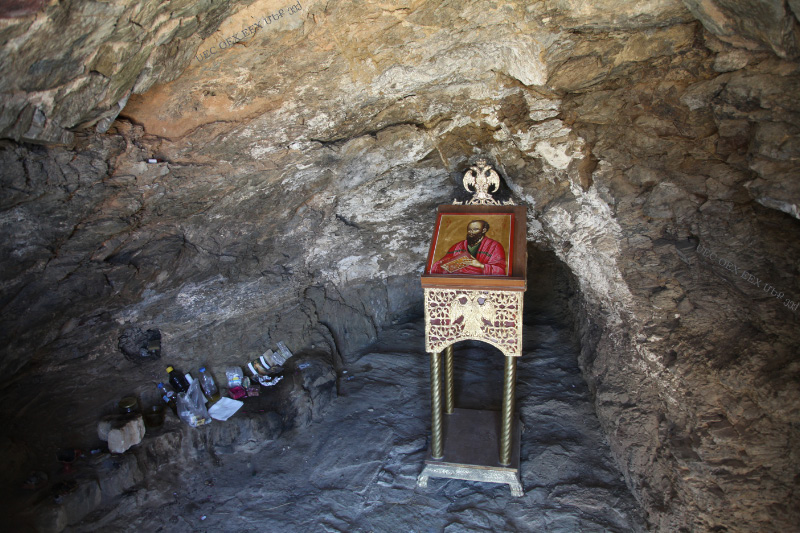 |
|
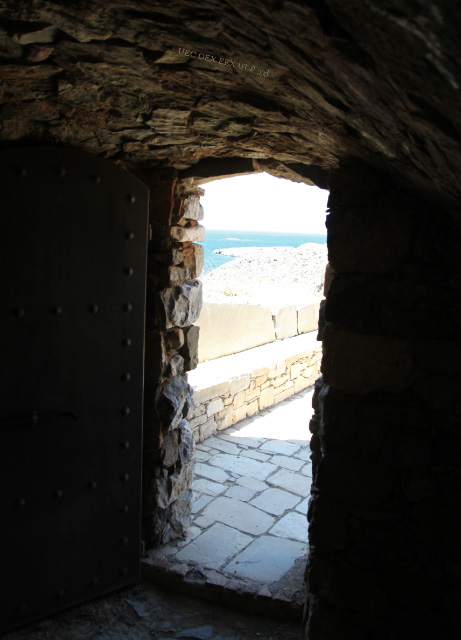 |
| Καλοί Λιμένες, Κρήτη - Kaloi Limenes, Crete - Fair Havens, that is, Good Harbors |
|
|
|
And when it was decided that we should sail for Italy, they delivered Paul and some other prisoners to a centurion of the Augustan Cohort, named Julius. And embarking in a ship of Adramyt'tium, which was about to sail to the ports along the coast of Asia, we put to sea, accompanied by Aristar'chus, a Macedo'nian from Thessaloni'ca. The next day we put in at Sidon; and Julius treated Paul kindly, and gave him leave to go to his friends and be cared for. And putting to sea from there we sailed under the lee of Cyprus, because the winds were against us. And when we had sailed across the sea which is off Cili'cia and Pamphyl'ia, we came to Myra in Ly'cia. There the centurion found a ship of Alexandria sailing for Italy, and put us on board.
We sailed slowly for a number of days, and arrived with difficulty off Cni'dus, and as the wind did not allow us to go on, we sailed under the lee of Crete off Salmo'ne. Coasting along it with difficulty, we came to a place called Fair Havens, near which was the city of Lase'a. As much time had been lost, and the voyage was already dangerous because the fast had already gone by, Paul advised them, saying, "Sirs, I perceive that the voyage will be with injury and much loss, not only of the cargo and the ship, but also of our lives." But the centurion paid more attention to the captain and to the owner of the ship than to what Paul said. And because the harbor was not suitable to winter in, the majority advised to put to sea from there, on the chance that somehow they could reach Phoenix, a harbor of Crete, looking northeast and southeast, and winter there.
And when the south wind blew gently, supposing that they had obtained their purpose, they weighed anchor and sailed along Crete, close inshore. But soon a tempestuous wind, called the northeaster, struck down from the land; and when the ship was caught and could not face the wind, we gave way to it and were driven. And running under the lee of a small island called Cauda, we managed with difficulty to secure the boat; after hoisting it up, they took measures to undergird the ship; then, fearing that they should run on the Syr'tis, they lowered the gear, and so were driven. As we were violently storm-tossed, they began next day to throw the cargo overboard; and the third day they cast out with their own hands the tackle of the ship. And when neither sun nor stars appeared for many a day, and no small tempest lay on us, all hope of our being saved was at last abandoned. As they had been long without food, Paul then came forward among them and said, "Men, you should have listened to me, and should not have set sail from Crete and incurred this injury and loss. I now bid you take heart; for there will be no loss of life among you, but only of the ship. For this very night there stood by me an angel of the God to whom I belong and whom I worship, and he said, `Do not be afraid, Paul; you must stand before Caesar; and lo, God has granted you all those who sail with you.' So take heart, men, for I have faith in God that it will be exactly as I have been told. But we shall have to run on some island."
When the fourteenth night had come, as we were drifting across the sea of A'dria, about midnight the sailors suspected that they were nearing land. So they sounded and found twenty fathoms; a little farther on they sounded again and found fifteen fathoms. And fearing that we might run on the rocks, they let out four anchors from the stern, and prayed for day to come. And as the sailors were seeking to escape from the ship, and had lowered the boat into the sea, under pretense of laying out anchors from the bow, Paul said to the centurion and the soldiers, "Unless these men stay in the ship, you cannot be saved." Then the soldiers cut away the ropes of the boat, and let it go. As day was about to dawn, Paul urged them all to take some food, saying, "Today is the fourteenth day that you have continued in suspense and without food, having taken nothing. Therefore I urge you to take some food; it will give you strength, since not a hair is to perish from the head of any of you." And when he had said this, he took bread, and giving thanks to God in the presence of all he broke it and began to eat. Then they all were encouraged and ate some food themselves.(We were in all two hundred and seventy-six persons in the ship.) And when they had eaten enough, they lightened the ship, throwing out the wheat into the sea. |
|
ως δε εκριθη του αποπλειν ημας εις την ιταλιαν παρεδιδουν τον τε παυλον και τινας ετερους δεσμωτας εκατονταρχη ονοματι ιουλιω σπειρης σεβαστης 2 επιβαντες δε πλοιω αδραμυττηνω μελλοντι πλειν εις τους κατα την ασιαν τοπους ανηχθημεν οντος συν ημιν αρισταρχου μακεδονος θεσσαλονικεως 3 τη τε ετερα κατηχθημεν εις σιδωνα φιλανθρωπως τε ο ιουλιος τω παυλω χρησαμενος επετρεψεν προς τους φιλους πορευθεντι επιμελειας τυχειν 4 κακειθεν αναχθεντες υπεπλευσαμεν την κυπρον δια το τους ανεμους ειναι εναντιους 5 το τε πελαγος το κατα την κιλικιαν και παμφυλιαν διαπλευσαντες κατηλθομεν εις μυρα της λυκιας 6 κακει ευρων ο εκατονταρχης πλοιον αλεξανδρινον πλεον εις την ιταλιαν ενεβιβασεν ημας εις αυτο
7 εν ικαναις δε ημεραις βραδυπλοουντες και μολις γενομενοι κατα την κνιδον μη προσεωντος ημας του ανεμου υπεπλευσαμεν την κρητην κατα σαλμωνην 8 μολις τε παραλεγομενοι αυτην ηλθομεν εις τοπον τινα καλουμενον καλους λιμενας ω εγγυς ην πολις λασεα 9 ικανου δε χρονου διαγενομενου και οντος ηδη επισφαλους του πλοος δια το και την νηστειαν ηδη παρεληλυθεναι παρηνει ο παυλος 10 λεγων αυτοις ανδρες θεωρω οτι μετα υβρεως και πολλης ζημιας ου μονον του φορτιου και του πλοιου αλλα και των ψυχων ημων μελλειν εσεσθαι τον πλουν 11 ο δε εκατονταρχης τω κυβερνητη και τω ναυκληρω μαλλον επειθετο η τοις υπο παυλου λεγομενοις 12 ανευθετου δε του λιμενος υπαρχοντος προς παραχειμασιαν οι πλειονες εθεντο βουλην αναχθηναι εκειθεν ειπως δυναιντο καταντησαντες εις φοινικα παραχειμασαι λιμενα της κρητης βλεποντα κατα λιβα και κατα χωρον
13 υποπνευσαντος δε νοτου δοξαντες της προθεσεως κεκρατηκεναι αραντες ασσον παρελεγοντο την κρητην 14 μετ ου πολυ δε εβαλεν κατ αυτης ανεμος τυφωνικος ο καλουμενος ευρακυλων 15 συναρπασθεντος δε του πλοιου και μη δυναμενου αντοφθαλμειν τω ανεμω επιδοντες εφερομεθα 16 νησιον δε τι υποδραμοντες καλουμενον καυδα ισχυσαμεν μολις περικρατεις γενεσθαι της σκαφης 17 ην αραντες βοηθειαις εχρωντο υποζωννυντες το πλοιον φοβουμενοι τε μη εις την συρτιν εκπεσωσιν χαλασαντες το σκευος ουτως εφεροντο 18 σφοδρως δε χειμαζομενων ημων τη εξης εκβολην εποιουντο 19 και τη τριτη αυτοχειρες την σκευην του πλοιου ερριψαν 20 μητε δε ηλιου μητε αστρων επιφαινοντων επι πλειονας ημερας χειμωνος τε ουκ ολιγου επικειμενου λοιπον περιηρειτο ελπις πασα του σωζεσθαι ημας 21 πολλης τε ασιτιας υπαρχουσης τοτε σταθεις ο παυλος εν μεσω αυτων ειπεν εδει μεν ω ανδρες πειθαρχησαντας μοι μη αναγεσθαι απο της κρητης κερδησαι τε την υβριν ταυτην και την ζημιαν 22 και τα νυν παραινω υμας ευθυμειν αποβολη γαρ ψυχης ουδεμια εσται εξ υμων πλην του πλοιου 23 παρεστη γαρ μοι ταυτη τη νυκτι του θεου ου ειμι ω και λατρευω αγγελος 24 λεγων μη φοβου παυλε καισαρι σε δει παραστηναι και ιδου κεχαρισται σοι ο θεος παντας τους πλεοντας μετα σου 25 διο ευθυμειτε ανδρες πιστευω γαρ τω θεω οτι ουτως εσται καθ ον τροπον λελαληται μοι 26 εις νησον δε τινα δει ημας εκπεσειν
27 ως δε τεσσαρεσκαιδεκατη νυξ εγενετο διαφερομενων ημων εν τω αδρια κατα μεσον της νυκτος υπενοουν οι ναυται προσαγειν τινα αυτοις χωραν 28 και βολισαντες ευρον οργυιας εικοσι βραχυ δε διαστησαντες και παλιν βολισαντες ευρον οργυιας δεκαπεντε 29 φοβουμενοι τε μη που κατα τραχεις τοπους εκπεσωμεν εκ πρυμνης ριψαντες αγκυρας τεσσαρας ηυχοντο ημεραν γενεσθαι 30 των δε ναυτων ζητουντων φυγειν εκ του πλοιου και χαλασαντων την σκαφην εις την θαλασσαν προφασει ως εκ πρωρης αγκυρας μελλοντων εκτεινειν 31 ειπεν ο παυλος τω εκατονταρχη και τοις στρατιωταις εαν μη ουτοι μεινωσιν εν τω πλοιω υμεις σωθηναι ου δυνασθε 32 τοτε απεκοψαν οι στρατιωται τα σχοινια της σκαφης και ειασαν αυτην εκπεσειν 33 αχρι δε ου ημερα ημελλεν γινεσθαι παρεκαλει ο παυλος απαντας μεταλαβειν τροφης λεγων τεσσαρεσκαιδεκατην σημερον ημεραν προσδοκωντες ασιτοι διατελειτε μηθεν προσλαβομενοι 34 διο παρακαλω υμας μεταλαβειν τροφης τουτο γαρ προς της υμετερας σωτηριας υπαρχει ουδενος γαρ υμων θριξ απο της κεφαλης απολειται 35 ειπας δε ταυτα και λαβων αρτον ευχαριστησεν τω θεω ενωπιον παντων και κλασας ηρξατο εσθιειν 36 ευθυμοι δε γενομενοι παντες και αυτοι προσελαβοντο τροφης 37 ημεθα δε αι πασαι ψυχαι εν τω πλοιω ως εβδομηκοντα εξ 38 κορεσθεντες δε τροφης εκουφιζον το πλοιον εκβαλλομενοι τον σιτον εις την θαλασσαν |
| |
Acts of the Apostles 27:1-38 |
|
|
ΠΡΑΞΕΙΣ ΤΩΝ ΑΠΟΣΤΟΛΩΝ 27:1-38 |
| |
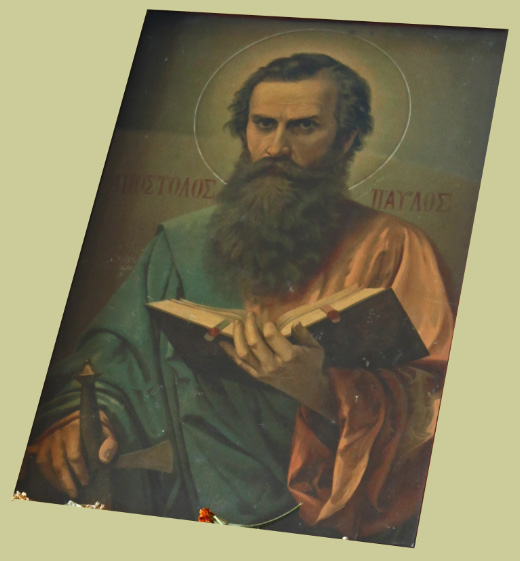 |
|
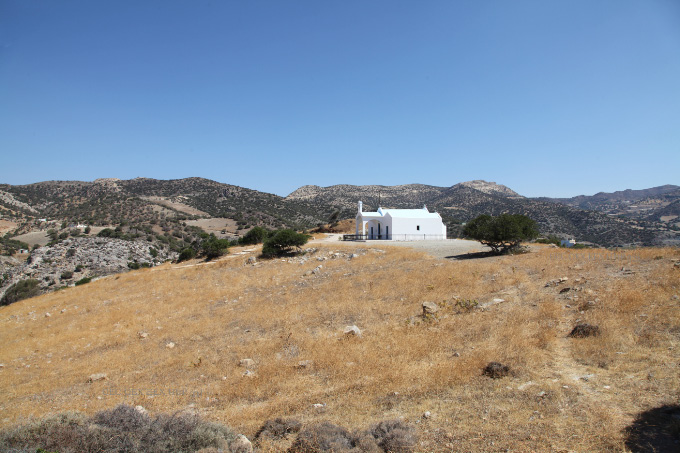 |
| |
|
|
|
| |
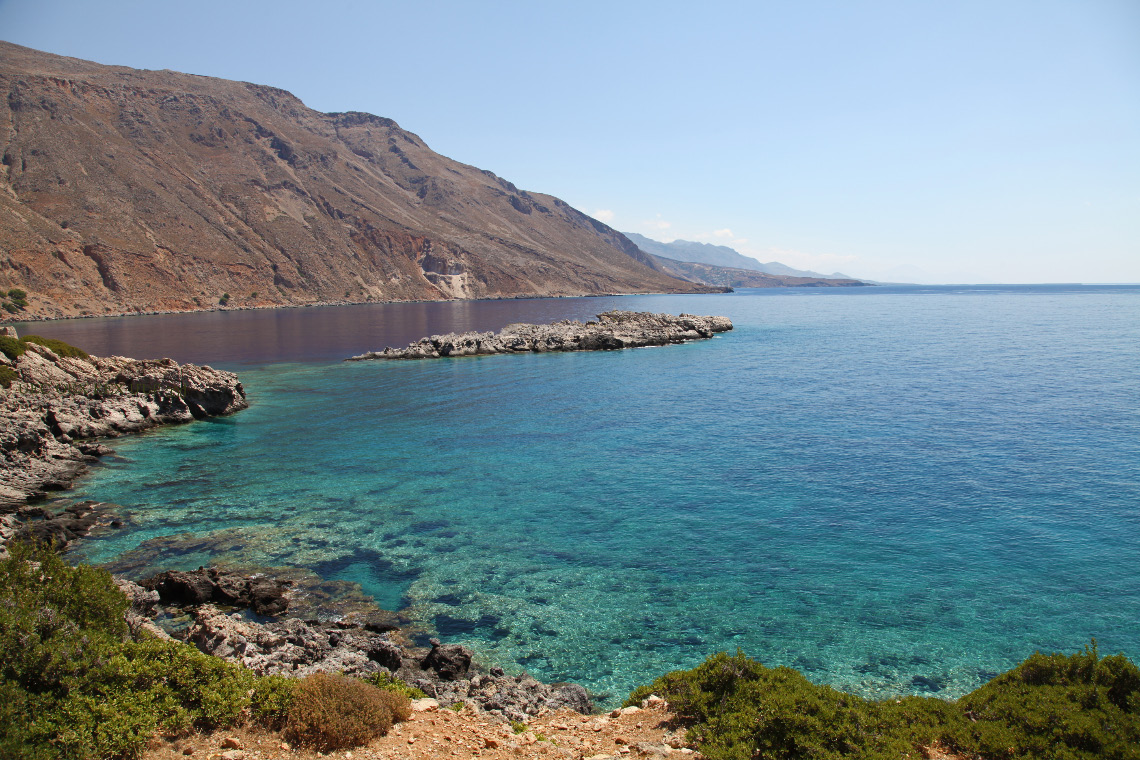 |
|
| |
... Phoenix facing southeast |
|
| |
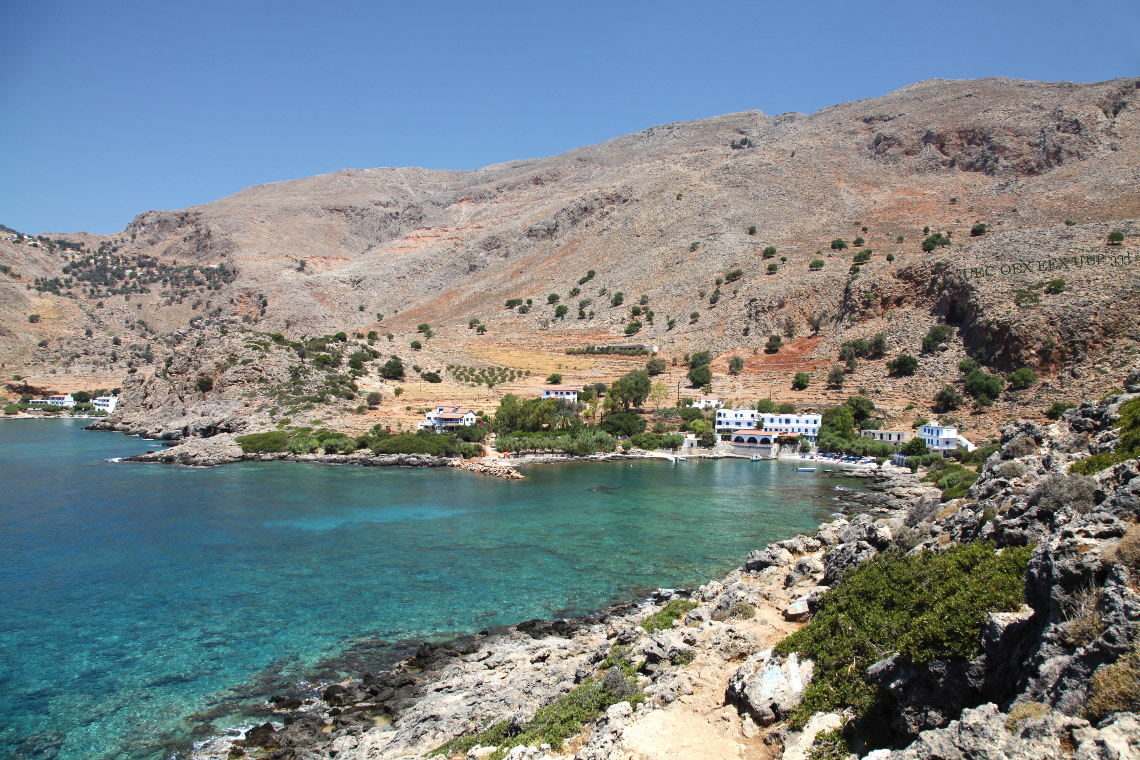 |
|
| |
Phoenix to southwest |
|
| |
Κύριος σκοπός της παρούσας ιστοσελίδας είναι να παράσχει και να διαδώσει πληροφορίες σχετικά με την ταινία «Ενωμένη Ευρωπαϊκή Χριστιανοσύνη – Ας Θεραπεύσουμε το Σχίσμα Τώρα». Κύριος σκοπός της ταινίας αυτής είναι να συνεισφέρει, με τη σειρά της, κατά κάποιο τρόπο στην επανένωση της Ορθόδοξης-Καθολικής Εκκλησίας και στην καθιέρωση ή την εκ νέου καθιέρωση της ευρύτερης πολιτισμικής ενότητας και ακεραιότητας στους κόλπους της Χριστιανοσύνης, ξεκινώντας από την Ευρωπαϊκή Χριστιανοσύνη. Η ταινία αυτή έχει σκοπό να μιλήσει στην κοινότητα των Χριστιανών πιστών. Υπό σημαντικές έννοιες, η ταινία «Ενωμένη Ευρωπαϊκή Χριστιανοσύνη – Ας Θεραπεύσουμε το Σχίσμα Τώρα» είναι μάλλον περισσότερο δύο ταινίες, παρά δύο τμήματα μίας ταινίας και αυτό συμβαίνει επειδή τα δύο θέματα που πραγματεύεται, ξεχωρίζουν πολύ το ένα από το άλλο. Το ένα θέμα, δηλαδή η Ευρωπαϊκή Χριστιανοσύνη, είναι εξαιρετικά σημαντικό. Το άλλο θέμα, δηλαδή η Εκκλησία, είναι ασύγκριτα πιο σημαντικό. Ας μην αναμένει κανείς να μην υπάρχουν προφανείς αντιθέσεις ως προς την κατανόηση του πώς πρέπει να διαχειριστεί η κοινότητα των Χριστιανών πιστών τα δύο αυτά ζητήματα.
Το πρώτο τμήμα, ας το αποκαλέσουμε πρώτη ταινία, επιχειρεί να ασχοληθεί με θεολογικά, εκκλησιολογικά και άλλα θέματα που εμπλέκονται στο σχίσμα του 5ου αιώνα στους κόλπους της Εκκλησίας και πιο συγκεκριμένα, επιχειρεί να ασχοληθεί με το Μεγάλο Σχίσμα στους κόλπους της εκκλησίας, το οποίο χρονολογείται κατ' έθιμον το 1054, ενώ ξεδιπλώθηκε μεταξύ του 9ου αιώνα και τις αρχές του 13ου αιώνα κι έπειτα. Δεδομένων των θεμάτων που εμπλέκονται, και καθώς αυτά ασχολούνται με τον αγώνα μας να κατανοήσουμε τους σκοπούς του Θεού για την Εκκλησία Του, οι διαμάχες δεν μπορούν να θεωρηθούν ασήμαντες. Δεδομένης της αντίληψης που μοιράζονται όλοι οι Χριστιανοί σχετικά με την εντολή του Θεού προς μια τέτοια ενότητα και η οποία αναπαρίσταται εμφανώς στην Αγία Γραφή και η οποία παρουσιάζεται στην παρούσα ιστοσελίδα, δεν είναι δυνατόν να θεωρήσει κανείς ότι οι διαμάχες αυτές δεν μπορούν να ξεπεραστούν.
Η τρέχουσα πραγματικότητα και τα γραπτά επιφανών διανοούμενων στους τομείς αυτούς, καθώς και οι διάλογοι και τα προγράμματα μεταξύ των ανώτερων ιεραρχών της Εκκλησίας, υποδηλώνουν ότι είναι δυνατή η ενιαία επανένωση μεταξύ των Εκκλησιών της Παράδοσης, εκείνων που έχουν διατηρήσει τα Μυστήρια -- και πάνω απ’ όλα την Ευχαριστία -- και της Αποστολικής Διαδοχής και του ιερατείου που έχει χειροτονηθεί με έγκυρο τρόπο. Όλοι οι άνω αναφερόμενοι, με αύξουσα σειρά ως προς τον αριθμό των ανθρώπων που περιλαμβάνονται στις κοινότητες των πιστών είναι (1) οι Ανατολικές Ορθόδοξες Εκκλησίες· (2) οι Ορθόδοξες Εκκλησίες που είναι σε Κοινωνία με το Οικουμενικό Πατριαρχείο της Κωνσταντινούπολης· και (3) η Καθολική Εκκλησία. Σε αυτόν τον κοινώς συμφωνημένο κατάλογο, ο δημιουργός της ταινίας αυτής θα ήθελε να προσθέσει και μια τέταρτη ομάδα. Αν και οι Ορθόδοξες Εκκλησίες και η Καθολική Εκκλησία επιχειρούν να αντιμετωπίσουν τις Εκκλησίες της ομάδας αυτής με το να μην τις αντιμετωπίζουν καθόλου και μάλιστα στο βαθμό πιθανώς να αγνοούν την ύπαρξή τους, αυτή η τέταρτη ομάδα μπορεί να συμπεριλάβει εκείνες τις Ορθόδοξες Εκκλησίες της Βυζαντινο-Σλαβονικής λειτουργικής παράδοσης, οι οποίες δεν είναι σε Κοινωνία με το Οικουμενικό Πατριαρχείο της Κωνσταντινούπολης. Η Ουκρανική Ορθόδοξη Εκκλησία, το Πατριαρχείο του Κιέβου, είναι μία μόνο από το μεγάλο αριθμό Εκκλησιών με πολυάριθμους πιστούς, που εμπλέκονται σε αυτό το εκκλησιολογικό χάος.
Όσο σημαντικοί και αν είναι οι Προτεστάντες για τη Χριστιανοσύνη, η εμφάνιση του Προτεσταντισμού και οι αμέτρητες διαιρέσεις στους κόλπους της δυτικής Εκκλησίας που ξεκίνησαν (με κάποιες μικρές εξαιρέσεις) από τον 16ο αιώνα, δεν αποτελούν μέρος της πρώτης αυτής ταινίας. Αποτελούν, ωστόσο, κατά σημαντικό βαθμό, τμήμα της ιστορίας που διηγούμαστε στη «δεύτερη» ταινία.
Η δεύτερη ταινία προσκαλεί το θεατή να ασχοληθεί με μια πολιτισμική ενδοσκόπηση σχετικά με το τι έχει κοστίσει αυτός ο Χριστιανικός διχασμός . Η ταινία αποτελείται κυρίως από μια σειρά μελετών περιπτώσεων σχετικά με το τι έχει κοστίσει το Σχίσμα. Προσκαλεί επίσης τον θεατή να προβεί σε μερικές ενημερωμένες υποθέσεις σχετικά με τη Χριστιανοσύνη, ξεκινώντας από τι μπορεί να αναμένει η Ευρωπαϊκή Χριστιανοσύνη, αν συνεχίσει να υφίσταται αυτή η κατάσταση του Χριστιανικού διχασμού. Πώς νομίζετε ότι τα πάμε; Πηγαίνουμε προς τη σωστή κατεύθυνση;
Η κοινότητα των πιστών θα καθορίσει τελικά αν θα λάβει χώρα αυτή η ενότητα της Εκκλησίας ή αν θα αποτύχει. Οι ιεράρχες της Εκκλησίας έχουν τους καθορισμένους ρόλους τους. Δεν είναι έτοιμοι να υπογράψουν κοινή δήλωση ή Αποστολικό Σύνταγμα ή κάποια άλλα έγγραφα που θα επαναφέρουν την Κοινωνία και την ενότητα και ακόμη και αν επρόκειτο να το κάνουν, αν δεν υπάρχει η υποστήριξη της κοινότητας των Χριστιανών πιστών, μια τέτοια δήλωση θα αποτύγχανε, όπως έγινε το 1439… και η σημαντικότερη εκκλησία της Χριστιανοσύνης έγινε Τζαμί.
|
|
| |
|
|
|
|
| |
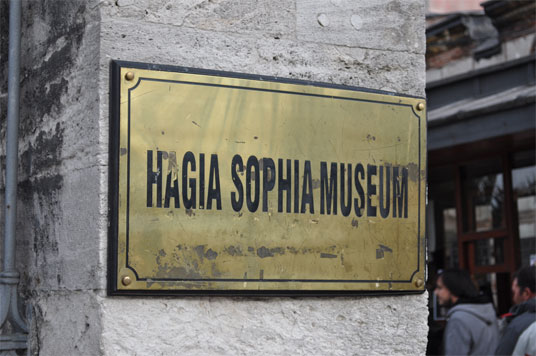 |
|
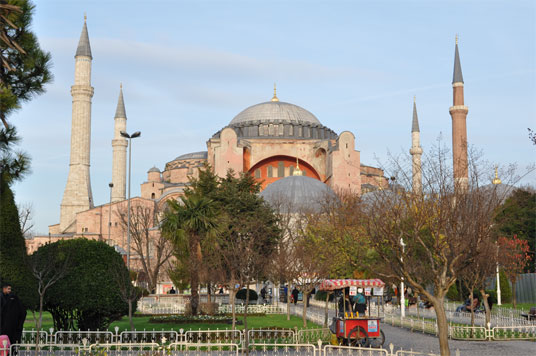 |
|
| |
|
|
|
|
| |
Επομένως, πρέπει να αποφασίσετε. Θέλετε αυτή την ενότητα;
Ξανασκεφτείτε αυτό το ερώτημα, αφού δείτε την ταινία. |
|
| |
|
|
|
|
| |
«Η διαίρεση έρχεται εμφανώς σε αντίθεση με τη θέληση του Χριστού, παρέχει πρόσκομμα στον κόσμο και επιφέρει ζημιά στον πιο ιερό σκοπό διάδοσης του Ευαγγελίου σε κάθε πλάσμα. Να πιστεύει κανείς στο Χριστό σημαίνει να επιθυμεί την ενότητα· να επιθυμεί την ενότητα σημαίνει να επιθυμεί την Εκκλησία· να επιθυμεί την Εκκλησία σημαίνει να επιθυμεί την κοινωνία της χάρης που αντιστοιχεί στο σχέδιο του Πατέρα από όλη την αιωνιότητα. Αυτή είναι η σημασία της προσευχής του Χριστού: «Ίνα πάντες εν ώσιν».
Ιωάννης Παύλος ο Β’, Παπική Εγκύκλιος, 1995
«Τα τείχη που μας χωρίζουν δεν φτάνουν στον ουρανό».
Μητροπολίτης Πλάτων του Κιέβου |
|
|
| |
|
|
|
|
| |
Άλλαι μεν βουλαί ανθρώπων |
|
Άλλα δε Θεός κελεύει |
|
| |
|
|
|
|
| |
|
|
|
|
| |
|
... Άγιον Όρος Άθως – Holy Mount Athosς.
|
|
|
| |
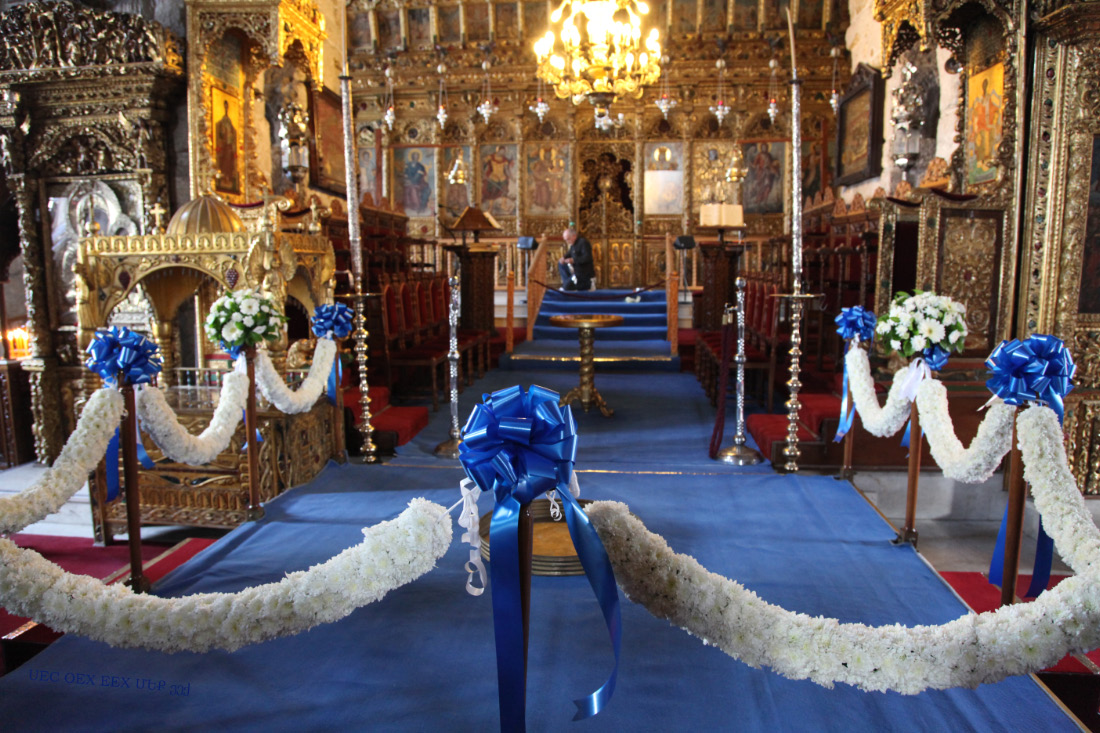 |
| |
|
Marriage preparations for an Orthodox Christian Greek Wedding
Άγιο Λάζαρο - Saint Lazarus of Bethany, from the Hebrew אלעזר — Elʿāzār or Eleazar, meaning "God is my help."
The Church of Saint Lazarus — Ιερός Ναός Αγίου Λαζάρου in Κίτιον-Kition, known today as Λάρνακα-Larnaca, Κύπρος-Cyprus, was built in the very late Ninth Century,
in recompense for Byzantine Emperor Leo VI having taken to Constantinople relics of Saint Lazarus which were discovered on the spot in 890. |
| |
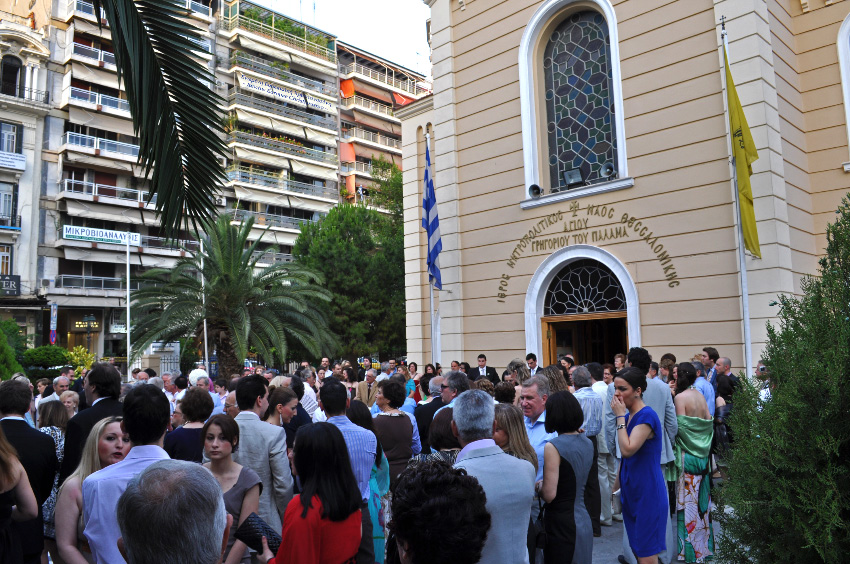 |
|
| |
Αγίου Γρηγορίου Παλαμά, Μητρόπολη της πόλης. and a Greek wedding, here in June of 2010 in Thessaloniki. |
|
| |
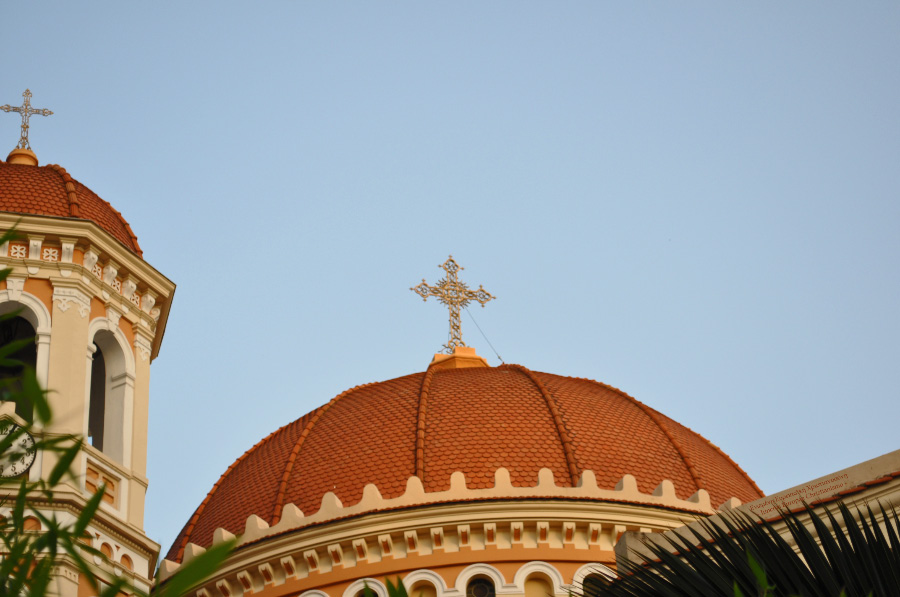 |
|
| |
Αγίου Γρηγορίου Παλαμά, Μητρόπολη της πόλης. Replacing a late 13th century three aisled Basilica, this earliest 20th century Metropolitan Church of Άγιος Γρηγόριος Παλαμάς – Saint Gregory Palamas in Thessaloniki was designed by the Saxon turned Greek Architect, Ernst Ziller – Ερνέστος Τσίλλερ. |
|
| |
|
|
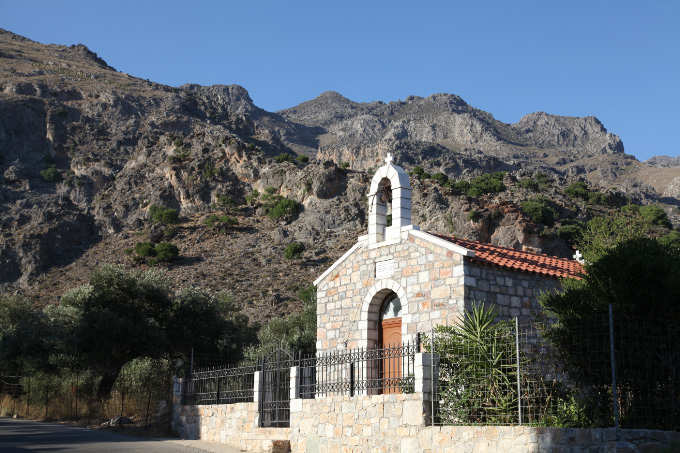 |
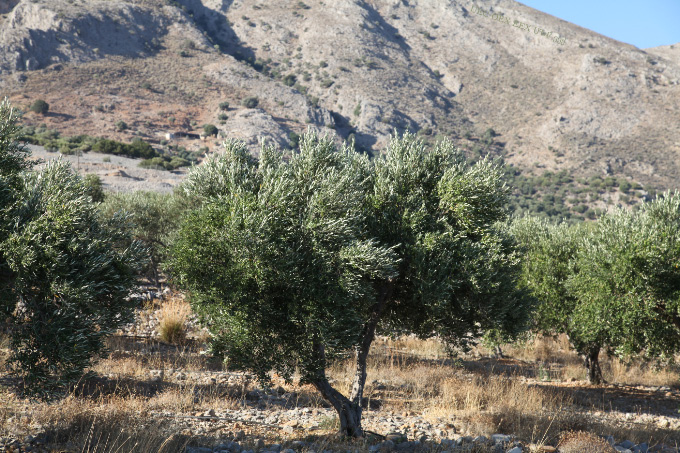 |
| ... a village Church near the southern shore of Crete |
|
|
|
|
| |
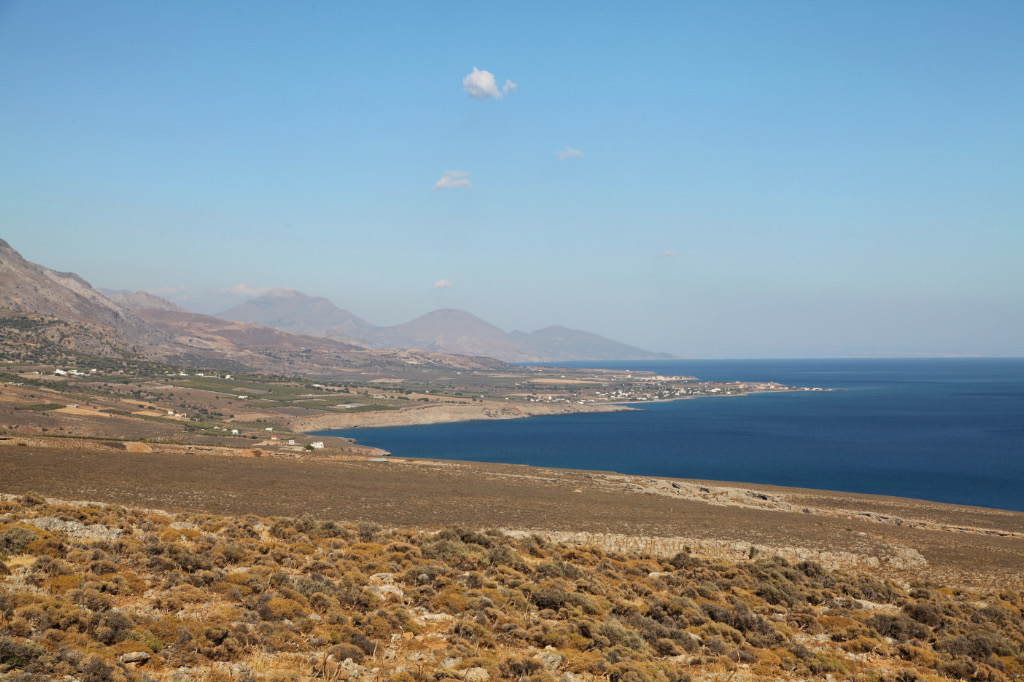 |
|
| |
... southern shore of Crete |
|
|
|
|
| |
|
|
| |
Άγιος Βασίλειος ὁ Μέγας – Святой Василий Великий – Saint Basil of Caesarea, Basil the Great (* c. 330 Caesarea, Cappadocia to 1 or 2 January 379 †)
and ,
Άγιος Ιωάννης ο Χρυσόστομος – Святой Иоанн Златоуст – Saint John Chrysostom (* c. 349 Antioch – Comana in Pontus 14 September 407 †),
both Doctors of the Church and, along with
Άγιος Γρηγόριος ὁ Ναζιανζηνός – Святой Григорий Богослов – Saint Gregory of Nazianzus, Gregory the Theologian (* c. 329 – 25 January 390 †),
| Οἱ Τρεῖς Ἱεράρχαι – Собор вселенских трёх Учителей и Святителей – the Three Great Hierarchs of the Universal Church. |
And other triplet is formed — The Cappadocian Fathers, or the Three Cappadocians — when, to Gregory of Nazianzus and Basil, Basil's younger brother is added:
Άγιος Γρηγόριος Νύσσης – Святой Григорий Нисский – Saint Gregory of Nyssa (* c. 335 – c. 395 †).
|
|
| |
The Orthodox Academy of Crete, operating under the spiritual auspices of His All Holiness the Ecumenical Patriarch of Constantinople,
though an impressive complex of buildings in an idyllic setting, is a disappointment. It is filled with reminders of the incessant efforts of some
to conflate and confuse the all holy re-unification of the Orthodox, Oriental Orthodox and Catholic Christians into the Orthodox-Catholic Church,
with decidedly unholy promotion of religious indifferentism and syncretism, so very often under the innocuous sounding banner of inter-faith dialogue.
One is reminded here of the standing practice of the Catholic Church to combine and confuse the offices and the missions of:
- the Pontifical Council for Inter-religious Dialogue (see www.vatican.va/roman_curia/pontifical_councils/interelg/index.htm ); and
- the Commission for Religious Relations with the Jews (see www.vatican.va/roman_curia/pontifical_councils/chrstuni/index.htm#Commission for Religious Relations with the Jews ),
both offices effectively the children of Pope Paul IV and Pope Saint John Paul II, as also the relationship of these two with:
- the Pontifical Council for Promoting Christian Unity (see www.vatican.va/roman_curia/pontifical_councils/chrstuni/index.htm ).
Consider please: is the intended and received combined message of these oft commingled missions one that all non-Catholic religions are equal?
Doctrinally this is decidedly not the case of course. See for example Catechism of the Catholic Church § 838 (www.vatican.va/archive/ccc_css/archive/catechism/p123a9p3.htm):
"The Church knows that she is joined in many ways to the baptized who are honored by the name of Christian, but do not profess the Catholic faith in its entirety
or have not preserved unity or communion under the successor of Peter." Those "who believe in Christ and have been properly baptized are put in a certain, although
imperfect, communion with the Catholic Church." With the Orthodox Churches, this communion is so profound "that it lacks little to attain the fullness that would
permit a common celebration of the Lord's Eucharist."
But see also § 15 of Lumen Gentium (noted in this same § 838 of the Catechism):
The Church recognizes that in many ways she is linked with those who, being baptized, are honored with the name of Christian, though they do not profess the faith
in its entirety or do not preserve unity of communion with the successor of Peter. (14*) For there are many who honor Sacred Scripture, taking it as a norm of belief
and a pattern of life, and who show a sincere zeal. They lovingly believe in God the Father Almighty and in Christ, the Son of God and Saviour. (15*)
They are consecrated by baptism, in which they are united with Christ. They also recognize and accept other sacraments within their own Churches or ecclesiastical communities.
Many of them rejoice in the episcopate, celebrate the Holy Eucharist and cultivate devotion toward the Virgin Mother of God.(16*) They also share with us in prayer and other
spiritual benefits. Likewise we can say that in some real way they are joined with us in the Holy Spirit, for to them too He gives His gifts and graces whereby He is operative
among them with His sanctifying power. Some indeed He has strengthened to the extent of the shedding of their blood. In all of Christ's disciples the Spirit arouses the desire
to be peacefully united, in the manner determined by Christ, as one flock under one shepherd, and He prompts them to pursue this end. (17*) Mother Church never ceases to pray,
hope and work that this may come about. She exhorts her children to purification and renewal so that the sign of Christ may shine more brightly over the face of the earth.
Taken together, the foregoing perhaps inclines one to conclude that there is something to the Russian Orthodox Church's view of itself as the leader and bulwark of Orthodoxy, the Third Rome,
or rather it would do, until one reflects that Russian Orthodox Metropolitans and Patriarchs slip into the same syncretism with each state-sponsored sing along with the Muftis and Chief Rabbis. |
| |
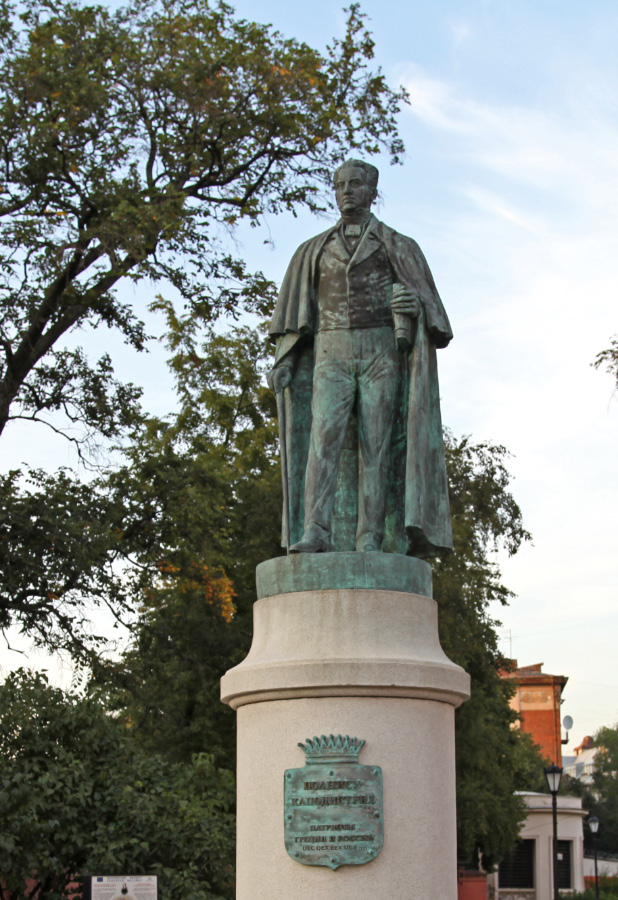 |
|
| |
Κόμης Ιωάννης Καποδίστριας – Conte Giovanni Antonio Capodistria – Граф Иоанн Каподистрия – Count Ioannis Antonios Kapodistrias
(* 10 February 1776 (O.S.) Κέρκυρα–Corfu — Nafplio–Ναύπλιο, capital of the First Hellenic Republic 9 October 1831 † )
Perhaps a Greek national in the Russian diplomatic service of Emperor Alexander I is an unlikely candidate for hero of Swiss unity
and independence (after Napoleon's interventions). Kapodistrias later served (1816-1822), jointly with the Baltic-German
Count Karl Robert Nesselrode, as Russian foreign minister to Alexander I. Kapodistrias took a leading role in organizing support for
Greek Independence from the Muslim Ottoman Turks, though noteworthily without the support of the Russian State and her Orthodox Tsar.
Indeed one might view this as a counterbalance, a prelude and perhaps, in the minds of some, a justification for betrayals a generation
later when British, French and Sardinian Christian states sided with the Muslim Ottoman Turks in the Crimean War of X 1853 – II 1856.
Though of course one should add (i) that the Greeks did not manage to avoid internecine battles among themselves even as they
struggled to rid themselves of a 400-year-old Muslim yoke, with more of the same in the aftermath of doing so; and (ii) such chains of
recriminations can be endless, and they certainly do not support the struggle for United European Christendom, unless by the stratagem
of instilling some much-needed humility in us all. The first head of state (Κυβερνήτης – Governor) of the just liberated Greece,
Kapodistrias served for four and one-half years from May 1827 until his assassination by other Greeks (Maniots) on 9 October 1831.
Monument in Некрасовский Сад – Nekrasovsky Park, Saint Petersburg – Санкт-Петербург |
| |
|
|
| |
|
Άγιο Όρος Άθως - Athos, the Holy Mountain |
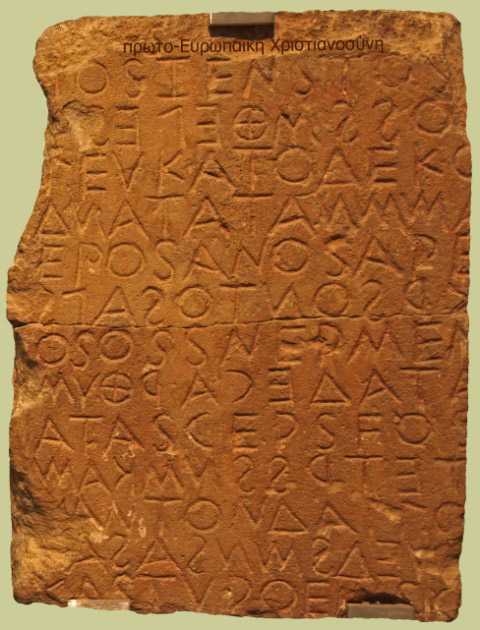 |
|
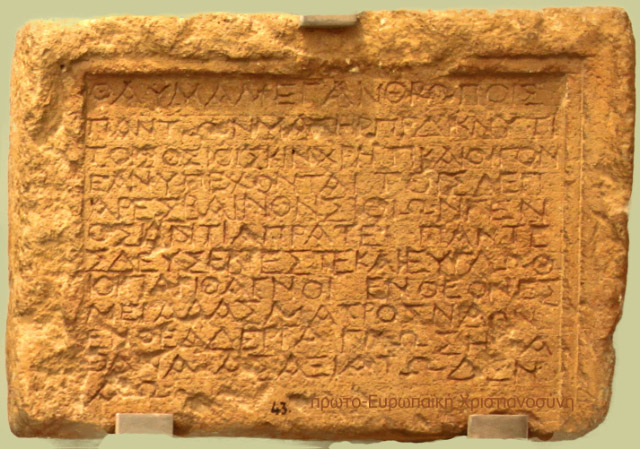 |
| 6th Century BC text from Gortyna refering to sacrafices to Zeus, Helios and other gods. |
|
Inscribed plaque with moral precepts and instructions for worshippers, who
enter the temple of the Great Mother in piety and virtue in search of the divine
truths. The text includes Homeric expressions and echoes the philosophical
beliefs of the Orphics, Phaistos, Hellenic period, 2nd c. BC. |
| |
|
|
|
|
Πυθαγόρας ὁ Σάμιος – Pythagoras of Samos
(c. 570 – c. 495 B.C.)
|
|
Ἡράκλειτος ὁ Ἐφέσιος – Heraclitus of Ephesus
(c. 535 – c. 475 BC)
|
|
Παρμενίδης ὁ Ἐλεάτης – Parmenides of Elea
(c. 515 – c. 455 B.C.) |
| |
|
|
|
| |
- Nothing comes from nothing.
|
| |
|
| |
|
| |
| |
| |
|
|
| |
|
|
|
|
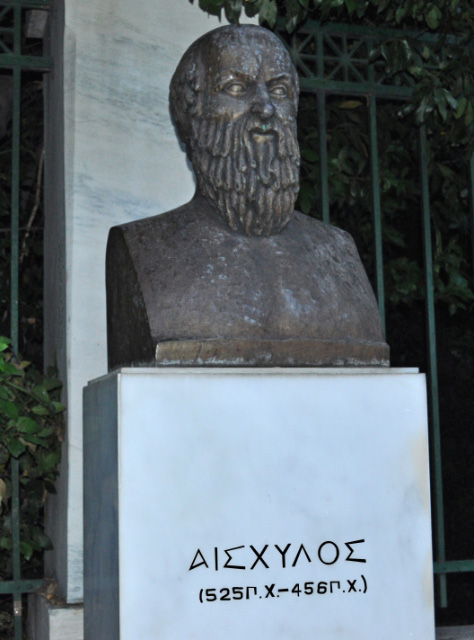 |
|
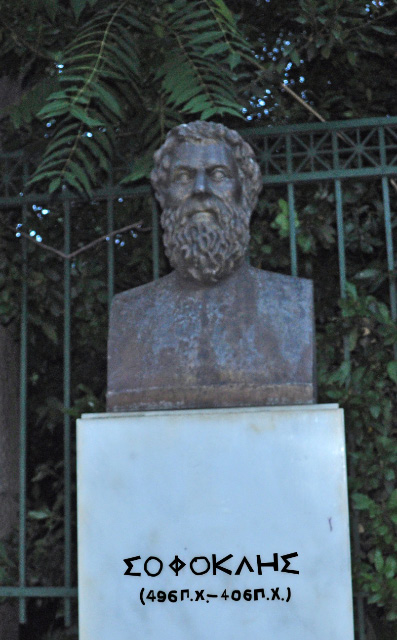 |
|
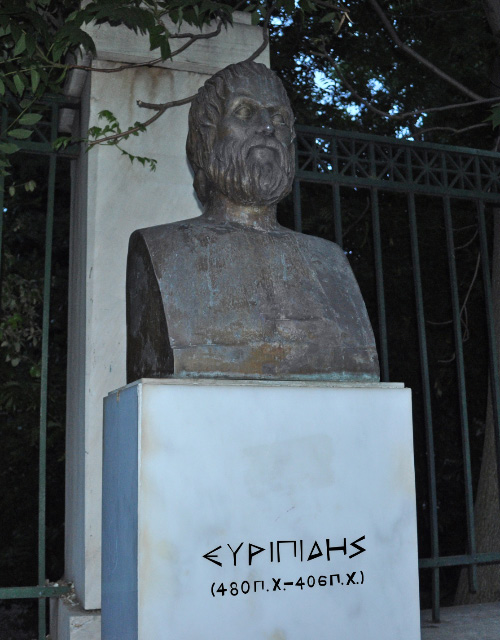 |
Αἰσχύλος – Aeschylus (525 – 456 B.C.)
|
|
Σοφοκλῆς – Sophocles (496 – 406 B.C.)
|
|
Εὐριπίδης – Euripides (480 – 406 B.C.) |
| |
|
|
|
bronze busts in Αθήνα – Athens |
| |
|
|
|
|
Σωκράτης – Socrates (c. 469 – 399 B.C.)
|
|
Πλάτων – Plato (c. 428/427 – 348/347 B.C.)
|
|
Ἀριστοτέλης – Aristotle (384 – 322 B.C.) |
| |
|
|
|
| |
|
| |
|
| |
|
| |
| There are two sorts of wealth-getting, as I have said; one is a part of household management, the other is retail trade: the former necessary and honorable, while that which consists in exchange is justly censured; for it is unnatural, and a mode by which men gain from one another. The most hated sort, and with the greatest reason, is usury, which makes a gain out of money itself, and not from the natural object of it. For money was intended to be used in exchange, but not to increase at interest. And this term interest, which means the birth of money from money, is applied to the breeding of money because the offspring resembles the parent. Wherefore of an modes of getting wealth this is the most unnatural. |
| |
Aristotle, from Book One, Part X of his Politics, written circa 350 B.C. [emphasis added] |
|
| |
|
|
|
Concentrating wealth in ever fewer and fewer hands and reducing workers to slaves. |
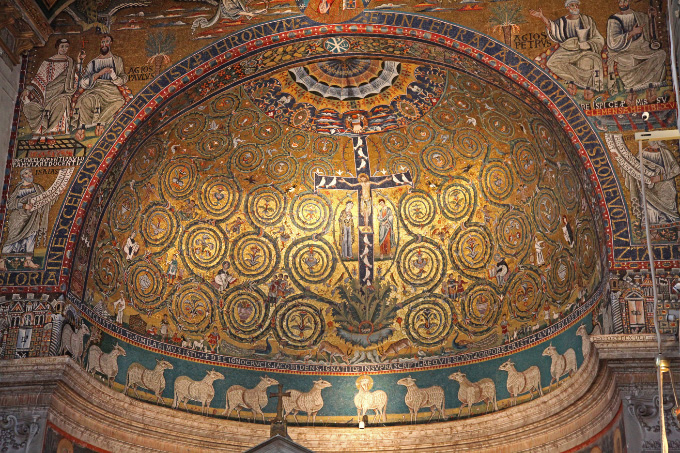 |
|
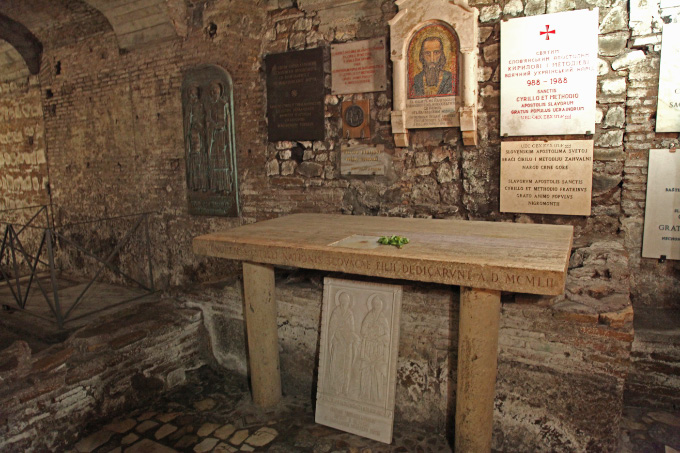 |
| Basilica di San Clemente al Laterano, Roma - Βασιλική του Αγίου Κλήμεντος, Ρώμη |
|
Άγιοι Κύριλλος - Sanctus Cyrillus - Свети Кирил - Свети Константин-Кирил Философ - Saint Cyril |
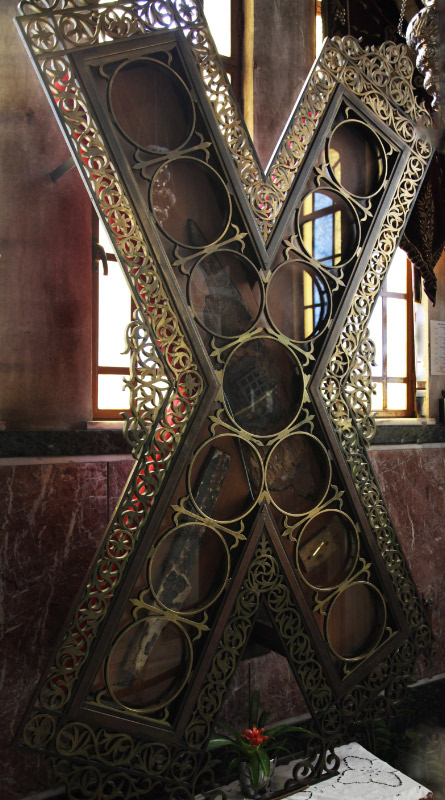 |
|
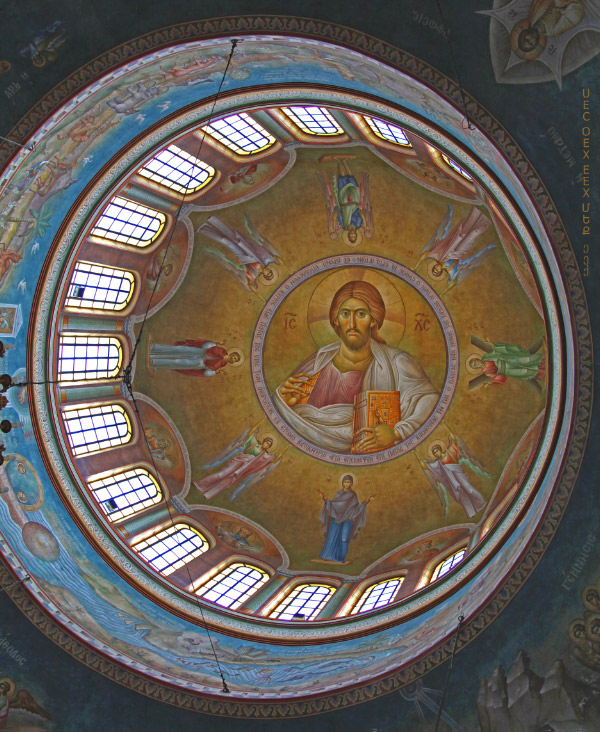 |
| fragments of the cross on which Apostle Saint Andrew was crucified ... |
|
Άγιος Ανδρέας - Saint Andrew's Greek Orthodox Basilica in Patras |
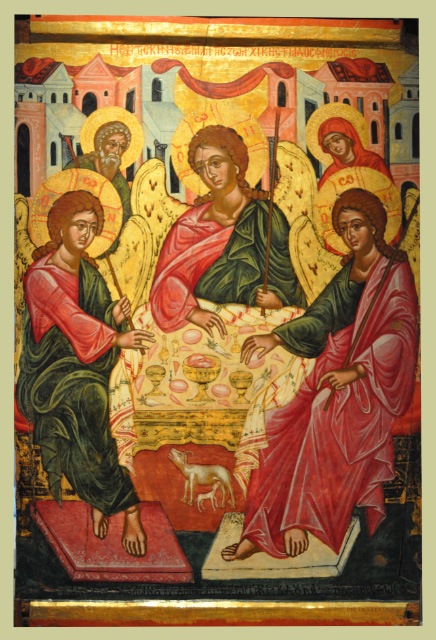 |
|
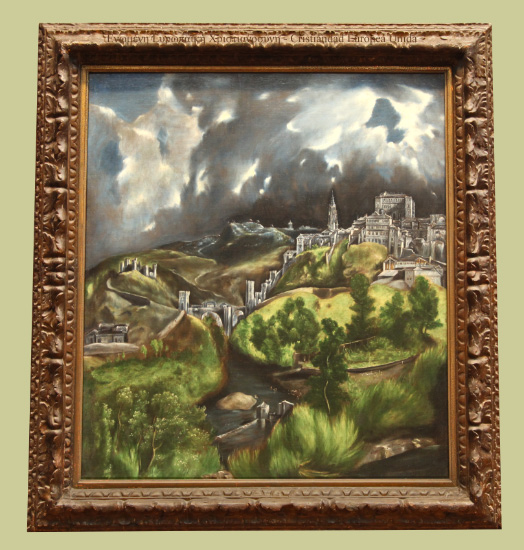 |
| Icon of Holy Trinity in the Museum of Byzantine Culture – Μουσείο Βυζαντινού Πολιτισμού, Θεσσαλονίκη – Thessaloniki. |
|
Vista de Toledo - View of Toledo, painting by El Greco in the MMA, NYC
Δομήνικος Θεοτοκόπουλος - Doménikos Theotokópoulos (1541, Crete - 1614, Toledo) |
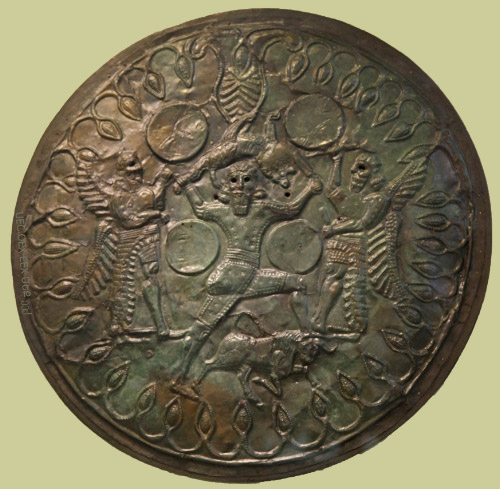 |
|
|
|
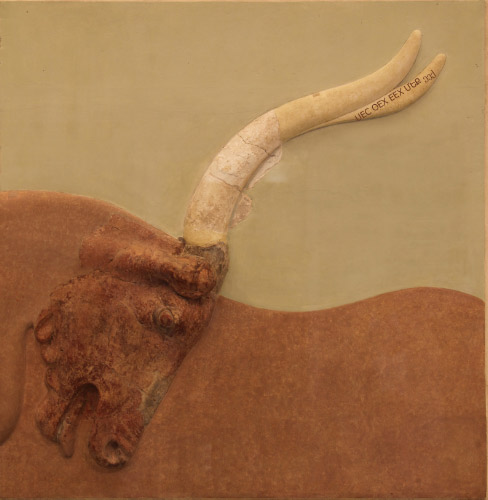 |
The Bronze Drum from the Idaean Cave.
Crete, Geometric Period - late 8th Century.
Kouretes beating drums to drown out infant Zeus'
cries from his father, the child-eating Kronos. |
|
|
|
Bull Hunting. Knossos Palace, Late Neopalatial Period, 1600 - 1450 BC |
|